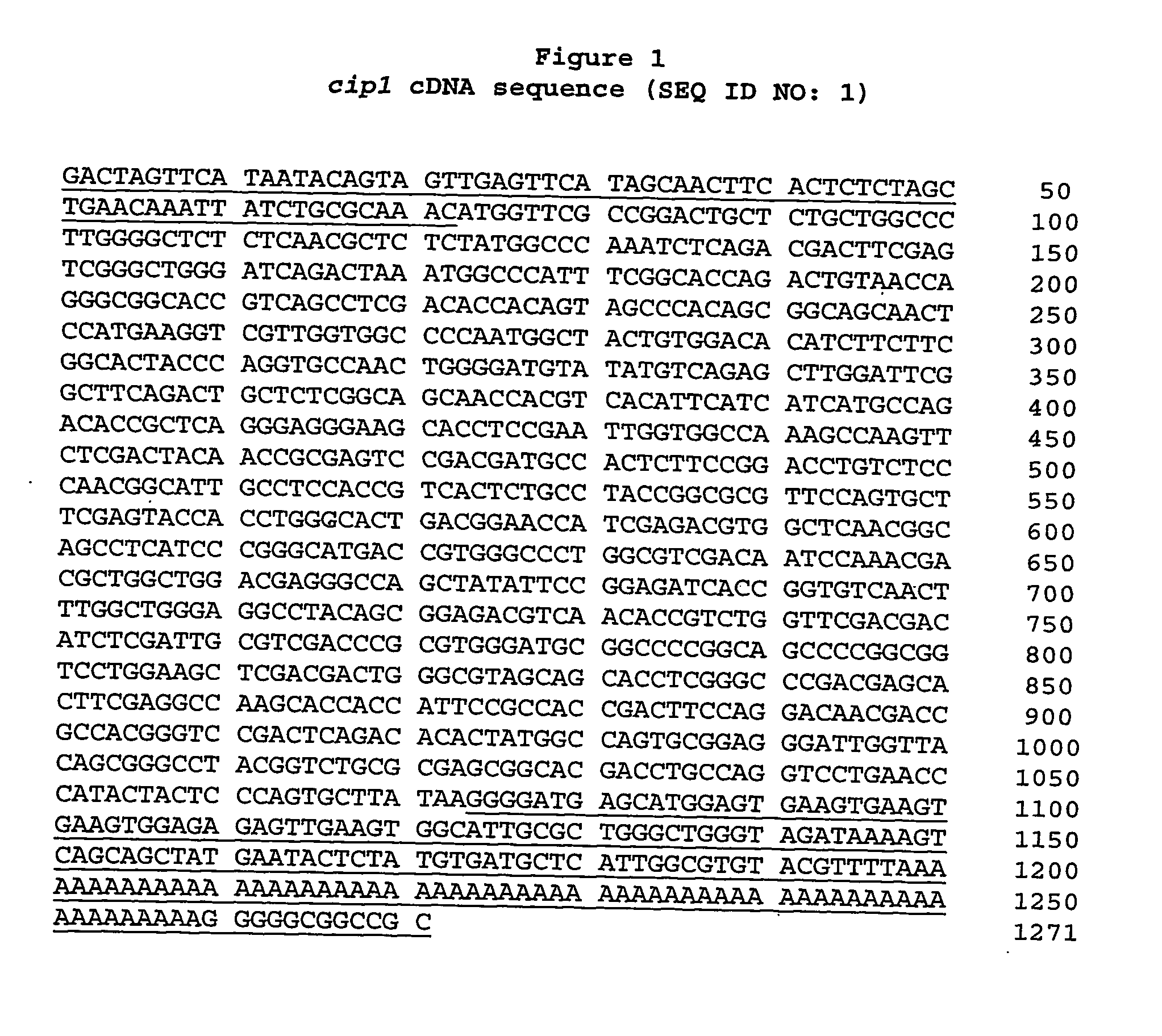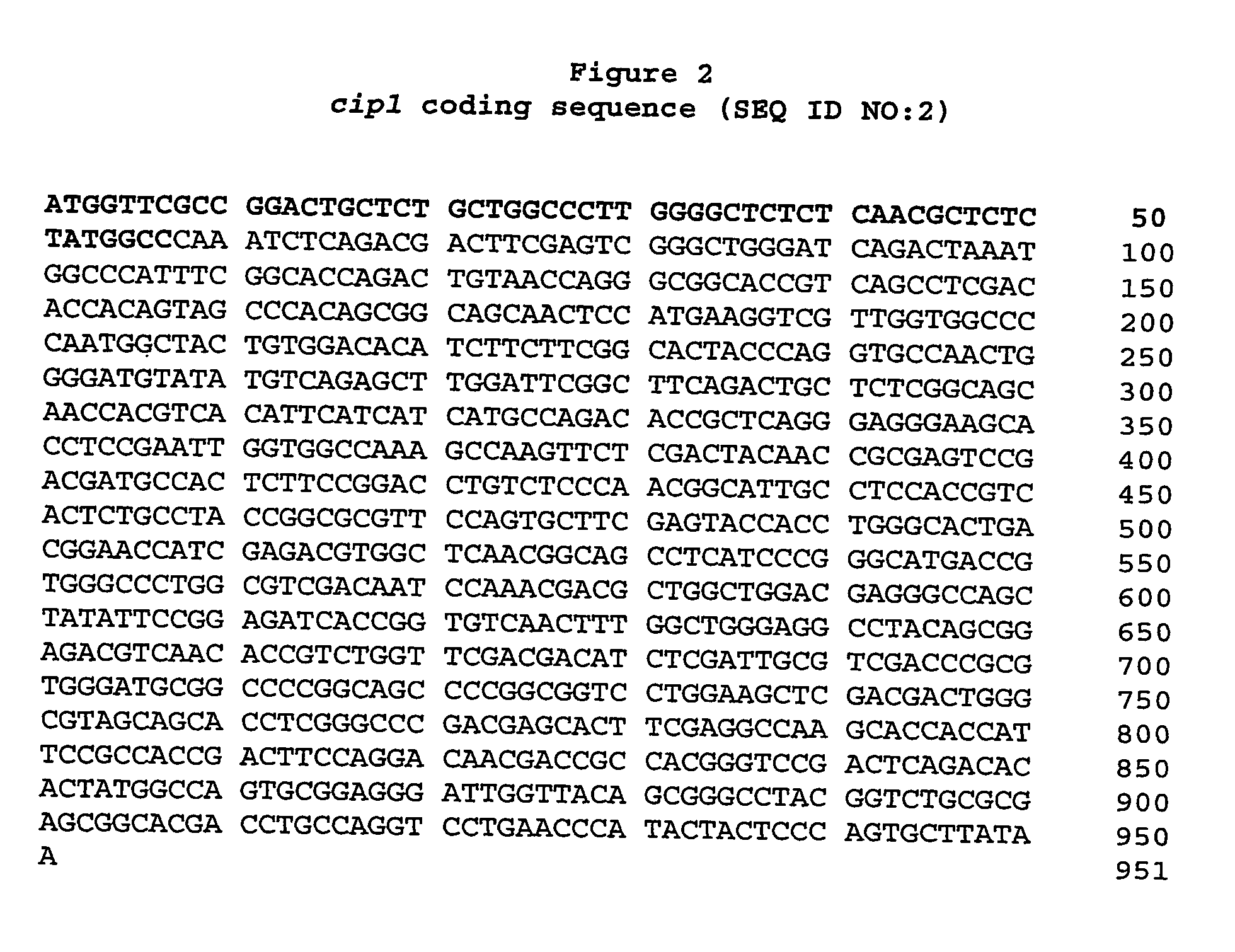Novel trichoderma genes
a trichoderma gene and gene technology, applied in the field of new trichoderma genes, can solve the problems of hampered cellulase use practicability
- Summary
- Abstract
- Description
- Claims
- Application Information
AI Technical Summary
Benefits of technology
Problems solved by technology
Method used
Image
Examples
example 1
Construction of T. reesei cDNA Libraries
[0254]T. reesei (ATCC 13631) was grown under different conditions to generate mycelium expressing growth condition-specific mRNA profiles. The RNA was then isolated, pooled and cDNA libraries were generated.
1A. Growth of T. reesei Mycelia
[0255] All cultures were grown in yeast extract / glucose (YEG) liquid medium overnight at 28° C. They were then transferred to the following conditions and cultured for the time stated at 28° C., unless otherwise indicated: [0256] Experiment 1: [0257] A. Vogel's +2% avicel, 3 days and 6 days [0258] B. Vogel's +2% solkafloc, 3 days and 6 days [0259] C. Vogel's +2% wheat bran, 6 days [0260] D. Vogel's +2% beet pulp, 6 days [0261] E. Solid state culture on wheat bran (15 g wheat bran, 1 g Proflo, 1 g solkafloc, 30 ml water), 7 days [0262] F. Solid state culture on beet pulp (15 g beet pulp, 1 g Proflo, 1 g solkafloc, 30 ml water), 9 days [0263] Experiment 2: [0264] A. Vogel's +2% glucose, 24 h [0265] B. Vogel'...
example 2
Identification of LT1-24 and the Cip1 Gene
[0353] The following rationale was used to find the cip1 gene: 1) Grow the library on Hybond+ membranes from Amersham; 2) Lyse the cells and fixate the library DNA on the membrane; 3) Hybridize the blot with the gene specific probes; 4) Hybridize the blot a second time, but now with a mixed CBM probe; 5) Subtract the gene specific from the CBM spots; and Select and analyze the new spots.
[0354] Colony Isolation
[0355] The cellulose induced cDNA library from T. reesei was used for these hybridization experiments. The E. coli cDNA library was plated out on agar plates (20×20 cm) to obtain a sufficient amount of clones.
[0356] cDNA libraries were plated on 200 ml 2xTY (Bacto-Trypton 16 g / l, Yeast Extract 10 g / l, NaCl 5 g / l) solidified with 1.5% agar in the presence of 100 μg / ml ampicillin (AMP). Efficient picking can be obtained when 1500 cfu are plated on 20×20 cm agar plates (Genetix, Q-Tray). 1 ml of the appropriate dilution was plated usin...
example 3
Identification and Sequence Analysis of T. reesei Genes of Interest
[0381] Partial sequencing of anonymous cDNA clones is a widely used technique for gene identification. These partial cDNA sequences, or Expressed Sequence Tags (ESTs) have potential application for the identification of important genes involved in cellulose degradation.
[0382] The plasmid containing a cDNA insert was isolated from clones of the libraries described in Example 1 and a single pass 5′ sequence of the cDNA insert was obtained from approximately 18,000 clones at North Carolina State University (Fungal Genomics Laboratory, College of Agriculture and Life Sciences, Raleigh, N.C.). Sequences of the cDNA were obtained using a primer corresponding to the vector sequence adjacent to the 5′ end of the cDNA insert. The sequences of individual sequence reads were compared and overlapping segments were assembled to form 2101 contigs consisting of two or more reads. 3030 individual reads did not have significant seq...
PUM
| Property | Measurement | Unit |
|---|---|---|
| temperature | aaaaa | aaaaa |
| weight percent | aaaaa | aaaaa |
| pH | aaaaa | aaaaa |
Abstract
Description
Claims
Application Information
 Login to View More
Login to View More - R&D
- Intellectual Property
- Life Sciences
- Materials
- Tech Scout
- Unparalleled Data Quality
- Higher Quality Content
- 60% Fewer Hallucinations
Browse by: Latest US Patents, China's latest patents, Technical Efficacy Thesaurus, Application Domain, Technology Topic, Popular Technical Reports.
© 2025 PatSnap. All rights reserved.Legal|Privacy policy|Modern Slavery Act Transparency Statement|Sitemap|About US| Contact US: help@patsnap.com



